Entries from September 2010
September 19th, 2010 · 1 Comment
Note: much of the following appears, verbatim, in this Thursday’s Dickinsonian. The formatless-format is explained there, but the manner in which it is done there is incongruous with this blog.
As our syllabus eloquently says, “London is too vast—as both a place and an idea—to grasp it all.” Conveniently, it’s more my style anyway to tell a few short anecdotes and leave it to the reader to weave them together rather than give one lengthy narrative.
That said, here are a few random moments that I’ll remember well after we’re back in the states.
On a subway ride back from Westminster one Sunday, a large man wearing a suit and tie (although his collar was covered in food) came up ranting and raving to our group of four Americans. “That guy sitting next to me over there was [fondling] his girlfriend! I don’t care if you do it a hundred times at home, but not on the f**king Tube! I AM TRYING TO CONCENTRATE!” It should be noted that this man, allegedly deep in concentration, was not reading, working, or listening to music. He was simply “trying to concentrate.” At first, I found this hilarious. But the more I thought about it, the more I thought it articulated the philosophy of the stoic and silent Brits we see every day on the Tube. Many do not read, many do not listen to music. But all do not speak to or make eye contact with each other. They’re just trying to concentrate.
_______
British women, or at least women in London, are really tall.
_______
We’ve taken all kinds of tours. We’ve toured places: Westminster Abbey, St. Paul Cathedral, the University of Oxford, Greenwich, Bloomsbury, the East End, and Stratford. We’ve done tours with themes: Marx’s London, Roman London, Restoration London. As Pat put it, though, “I’d like to take a trash cans, bathrooms, and water fountains tour, as there are none of those things in this city.” You can walk for miles in Westminster and not see a single trash can; they have all been removed from the area around Parliament and the prime minister’s residence because of susceptibility to terrorist attacks.
_______
Things in London close very early by American standards. Most restaurants outside of Burger King and McDonald’s are closed by 9:00 (or, as it’s known here, 21:00) and earlier on Sundays. So it was a major pleasant surprise when a few of us found a Subway that was open nightly until 5:00 AM. But it was extremely bewildering? Why this Subway, when four more from the same chain within two miles close around the usual London time?
This mystery was solved when it was realized that there was a strip club across the street that was open until 4:00 AM nightly.
Tags: 2010 Dennis · Uncategorized
September 19th, 2010 · No Comments
The thing about a city is you always end up missing the country and the thing about the country is you always end up missing the city. This paradox is one of the reasons I’ve been happily tucked away in a suburb for most of my life (I was born in Culver City, but we left Los Angeles before I had turned four)- give me access to the things in the city that I want but with the quiet and amenities only the country can provide.
London, however, has found a better solution to the need for getting away from the city: the plethora of parks and green space that dot the metropolis like a leaky pen on super-absorbent Bounty roll. I don’t understand the psychology of it, but there’s something about having a park, “a bit of earth” as the musical The Secret Garden says, that calms the human mind. Having somewhere to walk your dog, go for a run, bicycle around, take the kids roller-skating, have a picnic, read a book, whatever you wish, somehow relieves the pressures of city life. How the park-goers cope with inclement weather, I’ve yet to observe, but I know just finding “somewhere that’s green” (again, a musical reference – Little Shop of Horrors- I’m just on a roll tonight!) is seemingly vital to the psyche of any Londoner.
I began to feel this pull toward the park myself when I was heading over to visit the Queen’s Gallery at Buckingham Palace. I exited the Tube at the aptly-named Green Park station and discovered myself to be in the midst of an enormous, sprawling park, heavily populated with people (mostly families) spending the day outside and enjoying the weather. Touched by the idyllic scene, I snapped a photo and then starting heading over to the Palace. After turning one or two corners, it was as if I had travelled to a different world instead of only walking further away from the park. The peace and tranquility of the community park was replaced with loud, overexcited tourists, all eagerly clamouring for a photo of the Palace and/or the guards. People continually bumped into me as I tried to get to the Gallery and I had to look around me at all angles to make sure I didn’t step into anyone’s photos.
Viewing the gorgeous art at the Gallery refreshed me slightly but, after fighting my way back through the crowds around the Palace gate’s, I stopped in Green Park to take a breather before heading into the congestion and confinement of the Tube station.
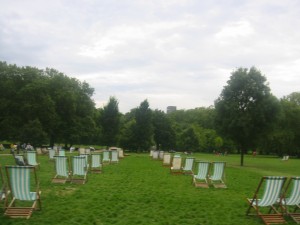 Where to find peace? Green Park!
Where to find peace? Green Park!
A young woman might have once needed a room with a view in Italy, but I began to understand just how much the English need their room and green views [see what I did there?]
Tags: 2010 Elizabeth
September 19th, 2010 · 3 Comments
I have been to many pubs in London, though probably not as much as some of my group members. The fact is, I don’t really like them. Before I came to England, I had the idea that pubs would be low-key and intimate places. I thought they would be places where I could relax. It turns out to be the opposite. I can’t relax at these places. I get extremely anxious. Pubs are where I actually have to act British, and I am not too sure yet what that means. I have read Fox and she has helped, but the times I actually experienced the pub scene for myself I’ve been confused. In the moment, I have a hard time thinking about what Fox has told me to do, and I just do what David always does… and it’s not always pretty.
One experience that I had was when Sean and I went to the Rising Sun. We made our way to the bar and, after probably five minutes of waiting, the bartender came and asked what we wanted. I ordered a pint of London Pride, and the guy asked if that was all and I said yes. But, then Sean said he wanted one too so I said, “Wait actually my friend wants one too.” Strike one. When you order, know what you want and order it all together. So the bartender gave me an attitude and then started to pour Sean’s drink. When he was finished, he gave us the price of the two drinks. We went fumbling through our pockets, full of random coins that we hadn’t yet learned by touch, so we could pay separately for the drinks we ordered. Strike two. Be ready with the money and pay together so the transaction can be fast, especially on a busy night like this one was. No need for a third strike, the bartender had no sympathy for the two confused Americans. When we eventually paid, we got our drinks and went to sit. We found a group of girls from the program, and I had to take Melissa with me when I wanted another drink because of how embarrassed I was. But experiences like this are not the only reason I don’t like pubs.
Pub food is garbage and the atmosphere is uncomfortable. I don’t care if its steak and ale pie, potato jackets, or a burger. The only thing that’s actually good is the fish and chips, but really how could anyone mess that up. This food is really missing all and any flavor that it could have. I really prefer to go to restaurants to eat and drink. The food is usually better and just as cheap. The drinks too are usually just as expensive. I like the slower pace of restaurants because I can eat and drink without people yelling and their elbows in my plate.
On a recent night, however, I was surprised to find a pub that I actually liked. It was small and quiet. When I looked in the window I hesitated before going in because it looked so low-key that I was worried it was a kind of a “regulars” spot. But when I walked in (with Sean) I found that it was exactly the kind of place I had been looking for! Sean and I were probably the youngest people there. There was no music. The place wasn’t full but the people there were actively engaged with who ever was across from them at their table. I felt relaxed, I felt comfortable, and I drank a lot. I think the pub’s name was the King’s Crown. It’s a little bit up Gower Street, on a street to the left. I recommend that before everyone leaves, they give this place a shot because I’m sure it’s different than any place you have been to so far. I will totally be going back before I leave.
I hope to find pubs, like the one I just spoke about, in Norwich. I know pub food is notoriously bad everywhere, but I just want a place I can relax and unwind. That’s it.
Tags: 2010 David · Uncategorized
September 19th, 2010 · No Comments
As a firm agnostic, I know I visited all the different religious sites (the churches, the mandir, the mosque, and the synagogue) with different feelings and expectations than many of my colleagues. While I found our visits to the non Judeo-Christian places particularly informative, I felt the same apathy during those visits that I felt at the other places of worship. We’ve been told over and over again that Britain is a secular country and, for me, that works out just fine. Understanding this, it should be no surprise that my two favorite buildings to visit were Westminster Abbey and St. Paul’s Cathedral, locations that I have heard many bemoan as having become too much like tourist attractions rather than churches.
I could have happily wandered about Westminster Abbey a whole day (so long as I could avoid the tourists with the bloody audio guides who were walking about like zombies!), visiting the different tombs and reading all the different plaques and memorials. The sheer amount of history in that building is staggering. Despite my lack of religion, walking around the tomb of Queen Elizabeth I was a profoundly moving, almost spiritual, experience. It was if the gap between the past and the present could be breached by the closeness of that past’s remnants.
 Me in front of Westminster Abbey
Me in front of Westminster Abbey
At St. Paul’s, I didn’t feel the tug of history quite as strongly but I was perhaps even more impressed with the artistic aspects of the building, particularly the interiors. Knowing my own limits (stupid asthma), I decided not to ascend the stairs to see the top and, instead, spent a long time looking at the different gorgeous paintings and mosaics, particularly those adorning the ceiling.
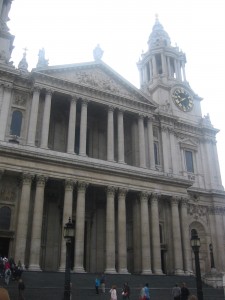 The entrance to St Paul’s.
The entrance to St Paul’s.
Something I noticed at both St. Paul’s and Westminster Abbey was the moment of silence/prayer that occurred during our visits. I applaud this attempt to remind visitors where they were but think it fell flat both times, as many tourists (particularly the children) ignored the announcement and continued on their merry way, many obviously still zoned out and intent on their audio guides. I think that the historic houses of worship in England need to make up their minds one way or another: do they want to remain religious buildings or give over entirely to tourism? This indecision has the buildings in an odd sort of limbo- not entirely sacred, but not secular either.
Tags: 2010 Elizabeth · Churches and Cathedrals
September 19th, 2010 · No Comments
I’m a huge theatre fan (always have been, always will be), so pretty much every moment of spare time I’ve had here that hasn’t been taken up by projects or illness has been spent at the theatre. Many people have already written about individual shows, so I’m going to try and give a comprehensive look at what I’ve seen here in London and where:
–The Merry Wives of Windsor, The Globe Theatre (Southwark/Bankside)
-The 39 Steps, The Criterion Theatre (Piccadilly Circus)
–Bedlam, The Globe Theatre (Southwark/Bankside)
–Aspects of Love, The Menier Chocolate Factory (Southwark)
– Les Miserables (the 25th Anniversary production), The Barbican Centre (Southwark)- TWICE
–Henry IV: Parts One and Two, The Globe Theatre (Southwark/Bankside)
–Passion, The Donmar Warehouse (Covent Garden)
–Wicked, The Apollo Victoria (Westminster)
I’m only going to mention my experiences at the Globe briefly, as I’ve been going to bat constantly in defense of Bedlam and it’s sort of exhausting! I found Merry Wives to be entertaining – it’s not one of my favourite Shakespeare plays, but the cast was fantastic. I saw Bedlam on opening night – its world premiere performance – and I was blown away by it. I wanted to go back and see it again but that didn’t end up working out, though I did pick up a souvenir program and a script on my Henry IV Marathon Day.
Ah, and speaking of Henry! . . . As part of the educational Shakespeare company I interned with for two years, I assistant directed Part One of Henry IV twice, so I was very familiar with the show. I decided to go on a day where I could see both Part One and Part Two which equalled about 8 hours spent in or near the Globe- HEAVEN! I thought the cast of both Parts gave extremely strong performances, particularly Roger Allam as Falstaff and Jamie Parker as Prince Hal. It was also entertaining to see cast members from Bedlam playing different roles, sometimes bit parts really, which made me pay much more attention to them. It was so interesting to see Sam Crane (the foppish Laurence in Bedlam) as Hotspur in Henry or Phil Cheadle, who stole my heart as Doctor Maynard in Bedlam, playing a trio of small roles (Douglas/Davy/Lord Bardolph), or Jason Baughan, the mad doctor in Bedlam, as Westmoreland/Peto, or even seeing Barbara Marten, the neglected wife in Bedlam, as the hillarious Mistress Quickly in Henry. My only complaint about the Henry plays is that I would have liked to see them before Merry Wives, as Merry Wives is the sequel to both Henry IVs and Henry V. Still, knowing the characters and what becomes of Falstaff in Merry Wives made the Henrys all the more enjoyable!
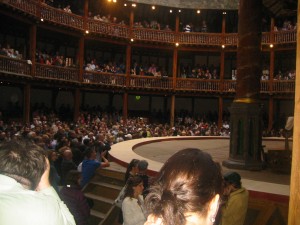 My view of Bedlam (taken during the interval, of course!)
My view of Bedlam (taken during the interval, of course!)
And me at the site of the original Globe.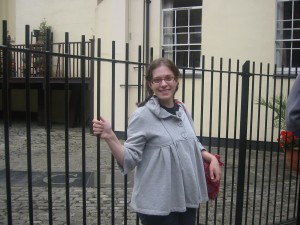
I was pleasantly surprised by The 39 Steps. I didn’t know anything about the play or the cast but, being a film fan, knew that the title at least came from a Hitchcock-type, film noir-ey movie. Imagine my surprise when I discovered it was more spoof than thriller! The Criterion itself was BEAUTIFUL, a gorgeous venue and perfect for such an affectionately-nostalgic play. The UK tour will be hitting Norwich in April, so I’m going to try and go to see if I like it as much with a different cast.
Now. Les Miserables. Bear in mind that I’ve seen Les Miz more times than I would like to admit, have more cast recordings than I’d like to count and in more languages than I should probably tell. This musical was a huge part of my life for about 3 years in high school and had a huge shaping effect on my musical tastes. I didn’t want to see the production at the Queen’s Theatre because it was a bit of “been there, done that”- let me explain to the uninitiated: pretty much all of the musicals Cameron Mackintosh produces (Phantom of the Opera, Cats, Les Miz, Miss Saigon, etc) are brilliant shows but get boxed up and set to be mass produced globally. That basically means, the blocking, lighting, staging, set, costumes, all the onstage “business” will be the same from production to production. That cross Valjean makes downstage left in the middle of Act 2 will be made by every Valjean from Alaska to Hong Kong. That was why, when I heard there was a special, newly restaged version being presented at the Barbican (the original home of Les Miz’s first production) in honour of its 25th Anniversary, I jumped at the chance to go.
To try and express how incredible this production was is beyond me at this point, particularly as I’m tired, sick and sniffly. Suffice it to say, it was MAGICAL. The creative team took a show that I know inside and out, blast its stitches apart and made it something fresh and new, while keeping the same heart, the very core of the show which I fell in love with in the first place. They did away with the annoying rotating stage and used a much more intimate, less intimidating set. New costumes. New orchestrations. New musical cuts. New lighting. I had goosebumps from the sheer awesomeness of it.
Which is why, after getting out of the show Wednesday night (the 15th), I immediately called my partner in crime and fellow Les Miz fanatic, Stephenie, and told her she NEEDED to get tickets. Before I quite knew where I was, we had tickets for the very next night’s performance and were seeing the show together. Seeing the show by myself had been amazing enough but having someone with me who could understand my strange musical-fan language and decipher from just an elbow in the ribs my excitement at the inclusion of a moment from the original novel into the stage production was beyond awesome!
 [At the Barbican. Photo grudgingly taken by Stephenie :D]
[At the Barbican. Photo grudgingly taken by Stephenie :D]
Oh, and we stood at the stage door to get our programs signed. Everyone but the two of us left after Gareth Gates (who played Marius and was, apparently, on the British version of American Idol, or something) had gone, so we were the only ones waiting for Valjean and the other leads- which is VERY STRANGE in the world of Stage Door. We had to call after John Owen Jones (who played Valjean, and is, in my mind, a demi-god) to get him to stop. So, we awkwardly stood at the stage door until 11:30pm (which, no doubt, led to my getting sick) until we decided to head back to the Arran House. We got on the tube at Barbican and decide to transfer to Moorgate so we can take the Northern line to Goodge. Still with me? So we’re walking through the station to get to the right platform and who should pass us? John Owen Jones (Valjean). Yep. And we were the only two at stage door, plus I was wearing my Les Miz shirt and Steph had her program out so we looked like complete stalkers. Did I mention he had left 20 minutes before we did? So how did he end up getting off at Moorgate at the same time? It astounds me . . . . And guess where he was headed? Yes, the Northern Line! He got into the same CAR as we did and Steph and I tried to remain calm and casually take some stealthy stalker photos of him (fail) but he got off at King’s Cross before we could succeed.
Going back a bit further, there is one theatrical experience which I must list as my favourite: Aspects of Love, at the Menier Chocolate Factory. This is one of Andrew Lloyd Webber’s least-well known shows (it is my personal favourite, even above Phantom of the Opera) and it was a miserable failure on Broadway and only played 3 years in London. I knew about the upcoming production before I had even left the States and I was thrilled, as this is the first major production in London since the original. This show is LITERALLY never put on, especially not in the United States (I saw a truly abysmal concert version in Los Angeles my senior year of high school which I’ve tried to erase from my memory). My pet theory on this is that it’s just not a flashy, pretty spectacle-type musical: it’s a deeply moving exploration about the agony of love as told through an incredibly complex story and fantastically beautiful music. To find out more about the show, take a look at: http://en.wikipedia.org/wiki/Aspects_of_love. The Menier is my favourite theatre I’ve visited so far- it is a huge success story, as it operates entirely without any government support and, thereby, is able to produce some truly incredible theatre. It has all the closeness and intimacy of a local community theatre with the talent of a full-scale West End production. Do check out their website: http://www.menierchocolatefactory.com/pages/about_us
The show itself was fantastic- I couldn’t have asked for a better production. To make things even better, I proved that Kate Fox is wrong about the English’s coldness and made friends with the girl working in the box office (whose name- Amanda- it only took me till the interval to find out!) as we mutually geeked out about how much we love the musical. I arrived home on a cloud of musical-induced bliss!
And, most recently, last night I saw Stephen Sondheim’s musical Passion at the Donmar Warehouse (http://www.donmarwarehouse.com/pl111.html) with Stephenie. As with Aspects of Love, this is a show whose music I know extremely well but which is not successful or oft performed because of its intensely emotional, cerebral nature. The Donmar is an incredible theatre – like the Menier, known for its intimate space- and it was the perfect setting for such an emotional complex and poignant piece of music as Passion.
 [Passion logo from: http://3.bp.blogspot.com/_1DZU-LyGw2Q/TFJkwODs5JI/AAAAAAAABLg/F-ss3TaKSSU/s1600/passion.jpg]
[Passion logo from: http://3.bp.blogspot.com/_1DZU-LyGw2Q/TFJkwODs5JI/AAAAAAAABLg/F-ss3TaKSSU/s1600/passion.jpg]
As for the last one on my list, Wicked, it’s a show I’ve seen often in Los Angeles. Stephenie and I (along with some others, I believe) are going Tuesday night before we head out of London. It’s by far the most commercial/touristy of the musicals I will have seen here, but I am looking forward to it nonetheless and am interested in seeing some changes that I believe were made to the show when it came here to London.
If I take away nothing else from this time in London, I’ll have gotten to see some damn good theatre!
Who could ask for anything more?
Tags: 2010 Elizabeth · Theatre
September 19th, 2010 · 1 Comment
I have now seen a total of five shows here in London. First, the Merry Wives of Windsor at the Globe Theatre, followed by the Czech Philharmonic concert at Royal Albert Hall, Les Miserables at the Queen’s Theatre, The 39 Steps at the Criterion Theatre, and The Habit of Art at the National Theatre. For this blog post, I will focus on The 39 Steps and The Habit of Art, because I think these shows have certain things in common that are a good demonstration of British culture.
Both shows were distinctly meta-theatrical. In The 39 Steps, costume and set changes happened right on stage and Professor Jordan proclaims the show’s self-consciousness when he is shot by a bodiless arm at the end of the show and shouts “This is supposed to be a four person cast!” The Habit of Art is a play within a play. Better yet, the play within the play is being rehearsed at the National Theatre, where the play is being shown. The rehearsal of Caliban’s Day is frequently interrupted by the actors, the stage manager, and the writer to talk about the trials and tribulations of acting, writing, and theatre. I think that both of these shows’ use of meta-theatre demonstrates the British love of irony and humor, their tendency toward self-consciousness and self-deprecation, and the Importance of Not Being Earnest Rule as defined by Kate Fox. Meta-theatre demonstrates that the show and the playwright are not taking themselves too seriously. When some of the class was talking during intermission, I remember Matt wondering why there couldn’t have just been a play about Auden and Britton, and why they had to go to the trouble of adding all the extra characters and putting it in a frame. He suggested that the playwright was too worried that a serious play about Auden and Britton would not go over well. This theory may be exactly right. A play just about Auden and Britton may have been reviewed with an “Oh come off it” rather than a “deeply and unexpectedly moving” and a “I can think of few plays that combine wild laughter, deep emotion, and technical ingenuity with such bravura” (Charles Spencer, Telegraph, 18 November 2009).
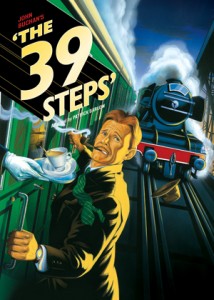
photo credit: Google Images
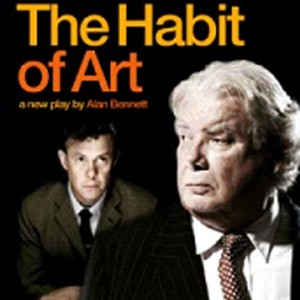
photo credit: Google Images
This is still just a theory. As a sidenote, I do think the framing had its merits. Caliban’s Day is about the pressure to create art, the artist’s consciousness of his role and reputation as an artist, and the contriving that goes on behind the scenes with the artist’s fear of biographical information seeping into or being read into his art. The insecure actors and writer and the ever-comforting and conciliatory stage manager are a parallel story to Auden’s and Britton’s, allowing the themes to be developed more deeply and thoroughly, applying them to theatre as well as poetry and music.
We have talked about theatre in London as being a sort of equalizer. Anyone who can afford even fifteen pounds can get a pretty good seat for a show. In the National Theatre, there are no restricted view seats nor are there any boxes. Everyone is on the same footing, and to demonstrate this, we got to sit in the same row as Sir Ian McKellen at The Habit of Art. While all of this is true, I still felt like a bit of an outsider at both of these shows. I really enjoyed The 39 Steps, but I still had some trouble catching all of the jokes, even after having read Fox and lived in London for a month. Many of the jokes, such as the jokes about Welsh politics and the “sorry, sorry, sorry” sequence on the train are distinctly British, and not fully accessible to us foreigners. The same held true with the humor in The Habit of Art. I’m not complaining; I’m sure American movies and plays present the same problems to the British. I do think I have a point though, in saying that the content in The Habit of Art was not accessible to just anyone. I think in order to fully understand the play, you needed a reasonable understanding of theatre and its operations (in this respect our backstage tour helped a lot) and an understanding of Auden’s biography, his poetry and The Tempest. It took me probably until close to intermission to grasp who all the characters were and the plotlines of both stories. I think the play was rather intellectual, despite containing much crude humor, and perhaps did not quite match the humble and universally accessible National Theatre.
Tags: 2010 Kaitlin
September 19th, 2010 · 6 Comments
Thanks to so many of you for asking about my experience at Pope Benedict XVI’s prayer vigil in Hyde Park yesterday afternoon. It was profoundly renewing spiritually and I’ll remember it for the rest of my life. I don’t want to get boring, soap-box-y, or too personal, so I’ll leave it at that.
But I would like to start a discussion, if anyone’s willing, about the controversy surrounding the Pope’s visit. I think this was a bit of a missed opportunity in class – the past few days have been historic, marking the Holy See’s first-ever state visit to the UK, first visit of any kind in 28 years, and perhaps most importantly, the beatification of Cardinal John Henry Newman, an Christian theologian from the Victorian Era and an important English figure, historically, intellectually, and religiously. (The beatification – or the penultimate step on the road to sainthood – of Cardinal Newman has taken a kind of backseat to the “state visit” thing. Actually, Newman is the main reason for the Pope’s visit. To learn more about the Cardinal – and why he’s so important to England and to the Church – read here: http://www.thepapalvisit.org.uk/Cardinal-Newman)
The visit’s official theme – “Heart Speaks Unto Heart” – comes from the writings of Cardinal Newman. Although Newman was a theologian and a professor at Oxford, he recognized the importance of faith deeply felt. He found in the Catholic Church what he considered to be a perfect union of intellect and spirit, mind and heart. You can probably guess why Benedict wanted to emphasize this aspect of Newman’s life to believers in England- we’ve spent plenty of time talking about how secular today’s England is. In his homily at Hyde Park, in front of an estimated 80,000 he encouraged Christians to join with Newman and “radiate” faith rather than just accepting it intellectually. He also recognized that believers in England fight a bit of an uphill battle as they try to live their faith in a nation that wants little to do with faith. The Guardian reported quite fairly, in my opinion, on the Hyde Park vigil here: http://www.guardian.co.uk/world/2010/sep/18/pope-benedict-hyde-park-speech

Waiting for Benedict in Hyde Park (personal photo)
What I’m driving at is that, in my experience, the Papal visit was tailored very carefully to fit the English character. The visit reflected a lot of what we’ve talked about in class, actually. He wanted to address secularism as well as a long history of religious strife – the altar at Hyde Park was set up, intentionally, very close to Tyburn, where Protestants and Catholics alike have been martyred. Benedict also, at other times during his visit, addressed the British tendency toward moderation – reminding them, essentially, to be moderate in moderation. He paid homage to the 70th anniversary of the Battle of Britain – pointing out that he was a child during the dark days of Nazi Germany, and expressing his gratitude for the sacrifices of British servicemen and women.
I mentioned the controversy surrounding the visit a little earlier, though. Although I’m sure most of us noticed the Scientologists protesting in their Guy Fawkes masks – a little paradoxically, considering that Guy Fawkes was Catholic, or maybe that’s the point – the main group protesting the visit is called Protest the Pope. Their official website contains a list of grievances against the state visit of Benedict XVI: http://www.protest-the-pope.org.uk/ Although they claim that 20,000 protesters came out to support their cause yesterday, the police can’t confirm that number and neither can I – really, I don’t know where all those people were hiding because we certainly didn’t notice them.
For me, at least, Protest the Pope’s arguments are flimsy. They’re essentially saying the Pope can’t have a state visit because he’s Catholic, as far as I can tell. And it seems to me that when 17.5% of your country accepts the moral authority of one person, the government has a vested interest in a good relationship with that person. Not to mention that the Holy See is an ally for the UK government on matters of worldwide poverty, healthcare, and education, of climate change and sustainability, of nuclear disarmament and peace.
There’s one last aspect to the religious controversy surrounding this visit: six Muslims were arrested in connection with an alleged plot to assassinate the Pope. Here’s some more information on that: http://www.telegraph.co.uk/news/newstopics/religion/the-pope/8010002/Pope-visit-sixth-man-arrested-over-alleged-assassination-plot.html. The men have been released without charges. But I can’t help but wonder how this will affect Britain’s religious climate as well. Until these arrests, the conflict was between Catholics and secularists. Now, there’s a whole new dimension. Will the Muslim community react with anger and outrage? Will some Catholics resort to discrimination and hate? Will the whole story be forgotten by tomorrow? It will be interesting to watch this unfold.
Sorry for the length of the post – I just wanted to give some background on the visit and see if anyone has thoughts to share. I think this would be a good space to have a respectful dialogue about the place of religion in the British government.
Tags: 2010 MaryKate
September 19th, 2010 · No Comments
I’ve said this before but I’ll say it again, in case anyone has missed it: I’m a huge Anglophile. If it’s English, it’s pretty much guaranteed that I’ll love it. Coming to the UK has literally been the fulfillment of a lifelong dream. A huge part of why that is lies in the museums it has to offer.
As an English major specialising in 19th Century British Literature and a Medieval & Early Modern Studies Major focusing on Shakespeare and the history of the Tudor dynasty, I’ve been most excited about the museums whose collections have items specifically to do with my areas of interest. These are not always the ones you would think: for example, the British Museum turned out to be somewhat disappointing to me [not to discount its quality or credit at all: I mean, the Rosetta stone was pretty damn cool, as were the Lamassus that I studied in my summer art history course and then got to see in the flesh . . . errr, in the stone?] but the highlight of my visit was the following:
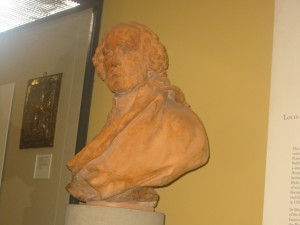
a bust of Shakespeare
and 
Engravings of Henry VIII
[all photos, unless otherwise mentioned are personal]
Disappointing, no? I thought so.
On the other hand, I was magnificently surprised by the museums we visited in Greenwich. Having no interest in science whatsoever, I thoroughly enjoyed walking around the Greenwich Observatory, particularly the Octagonal (?) Room:
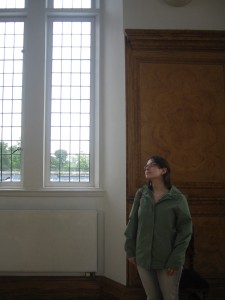 The Queen’s House too was a lovely surprise. Unfortunately, I left my camera in my bag which I checked when we came in, but imagine this scenario:
The Queen’s House too was a lovely surprise. Unfortunately, I left my camera in my bag which I checked when we came in, but imagine this scenario:
Elizabeth has somewhat unwillingly accompanied her friends into the Queen’s House. No sooner does she enter the first gallery but with whom does she come face to face?
 That’s right. My good buddy Henry the Eighth (photo courtesy: http://www.nmm.ac.uk/visit/exhibitions/on-display/the-tudors-at-greenwich-gallery)
That’s right. My good buddy Henry the Eighth (photo courtesy: http://www.nmm.ac.uk/visit/exhibitions/on-display/the-tudors-at-greenwich-gallery)
I enjoyed the Museum of London and the Docklands Museum too but (as I later discovered) because I had picked up some sort of stomach flu, I wasn’t really in the best state of mind to appreciate them fully. I plan to revisit the Museum of London tomorrow – if I’m up to it, for now I’ve got some weird ear, nose and throat infection – and take lots of photos (I had my camera with me when we went as a class, but it decided to die halfway through the Plague presentation). I particularly enjoyed looking at their Vauxhall Gardens presentation and the recreation of Dickens’ London.
I have already expressed my opinions of the National Portrait Gallery elsewhere (http://blogs.dickinson.edu/norwichhumanities/2010/09/national-portrait-gallery-my-two-pence/) but will emphasise again the sheer joy I experienced seeing up close and personal paintings that I’ve looked at in textbooks countless times, particularly this one:
 [Elizabeth I coronation portrait- http://www.npg.org.uk/collections/search/portrait/mw02070/Queen-Elizabeth-I?sText=queen+elizabeth&submitSearchTerm_x=0&submitSearchTerm_y=0&search=ss&OConly=true&firstRun=true&LinkID=mp01452&role=sit&rNo=2)
[Elizabeth I coronation portrait- http://www.npg.org.uk/collections/search/portrait/mw02070/Queen-Elizabeth-I?sText=queen+elizabeth&submitSearchTerm_x=0&submitSearchTerm_y=0&search=ss&OConly=true&firstRun=true&LinkID=mp01452&role=sit&rNo=2)
I’m uncertain whether or not to call our visits to places like Stonehenge, Wesminster Abbey, the Tower of London, or the Roman Baths (in Bath) “museum visits” but, while I had a tremendous time at all of this sites HUGELY significant to my areas of interest, I couldn’t help but notice that they had been “tourist-ized.” Case in point: at the Tower of London, as you look at the stairs where the bones of the two murdered Princes (http://en.wikipedia.org/wiki/Princes_in_the_tower) were supposedly found, you would hear sound effects on a loop which included such gems as “Mother! Where are you?” and “I thought I was supposed to be king.” This made it feel more like Disneyland and the walkthrough of Sleeping Beauty’s Castle than anything else I’ve seen here so far. Also, they look “interactive displays” perhaps a bit too far:
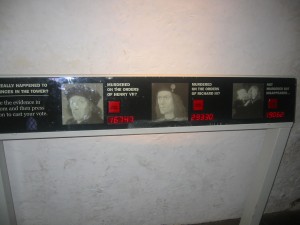 Yes. An electronic counter which allows visitors to vote on who they think murdered the princes. Besides the sheer cheesiness of this attraction, I’m quite irritated to see that Richard III is still getting the rotten end of the stick. Our dear tour guide John agrees with me on this!
Yes. An electronic counter which allows visitors to vote on who they think murdered the princes. Besides the sheer cheesiness of this attraction, I’m quite irritated to see that Richard III is still getting the rotten end of the stick. Our dear tour guide John agrees with me on this!
Beyond the sometimes-unbearably touristy nature of the Tower’s displays, it was still incredible to stand in the buildings where so much history – history that is of particular interest to me – went down.
I’ve gone to quite a few museums by myself as well. Much as I love our group, sometime it’s nice to go at your own pace or go somewhere that not everyone would want to go. Holly and I experienced this in our visit to the Jane Austen Centre in Bath which, for us, having taken English 399 with Professor Moffat on Austen, didn’t really contain anything we didn’t already know (thanks, Moffat!) but was good fun nonetheless:

On one of our free days, I hit two museums I particularly wanted to see: the Tate Britain (NOT the Tate Modern *shudder*) and the Queen’s Gallery at Buckingham Palace.
First of all, I wanted to see the Tate specifically for a portrait of Elizabeth I that I had read was in their collection which, upon visiting, I discovered was either an error on my part or had been taken off display. Nevertheless, I enjoyed wandering around the galleries, particularly when I came across these two pictures, side by side:


On the top, “Ophelia” by Sir John Everett Millais and “The Lady of Shallot” by John William Waterhouse on the bottom.
Both of these paintings are iconic to me and a print of the “Ophelia” adorns the door to my bedroom at home.
As for the Queen’s Gallery, I was thrilled to go for several reasons. First, I wanted to see Buckingham Palace without being a total tourist about it. Second, the current exhibition was entitled Victoria and Albert: Art and Love and I think Victoria and Albert have one of the sweetest love stories in history.

Third and most important, one of the core components of the exhibition was works by Franz Xaver Winterhalter, my ALL TIME FAVOURITE artist, a court portrait painter who painted at least 120 works for Victoria and her family. Again, the special joy here was seeing up close and personal works that I have previously drooled over in textbook or digital format, such as these two :
:
 Victoria and Albert, by Winterhalter.
Victoria and Albert, by Winterhalter.
From the Royal Collection (http://www.royalcollection.org.uk/microsites/vanda/MicroSection.asp?themeid=841)
This is, obviously, not a final account of my museum experiences in London and England as a whole. I fully expect to enjoy more in the next few days (hopefully, if I can get myself feeling better) and many repeat visits over the course of the year.
Tags: 2010 Elizabeth · Museums
September 19th, 2010 · 5 Comments
In the last month, I have seen Merry Wives of Windsor, Bedlam, Les Miserables, 39 Steps, and The Habit of Art, which is significantly more theater in a very short time than I’ve been able to see in the US. So that being said, I have to get my initial gushing about how excited I am that I’ve had this great opportunity and how it’s really great that London makes its arts so cheap to attend and accessible to the public. I say this mostly because I’m genuinely thrilled. I really can’t get over how awesome it is that I get to see all this stuff as part of a class for really cheap. I think that although Kate Fox talks about the English egalitarian sentiment as a largely hypocritical façade for a very unequal class system, the English really do an amazing job of making beauty accessible to everyone – free museums, cheap theater, beautiful parks, etc. (I also say this because my mom keeps reading my Dickinson blog – hi Mom! – and it’s a super cranky blog because American Studies has trained me that when I analyze, I must be angry and critical of society). But anyway, everyone has already talked about the accessibility of beauty. So I’m going to do the other thing that American Studies has trained me for: talk about something inappropriate and pretend it’s academic.
Today’s topic is cross-dressing. Out of all the plays I’ve seen, Les Mis was the only one that did not contain a prominent cross dressing scene, and it’s not English in origin. Bedlam was so intent on having a cross-dressing scene that it didn’t even matter that there was no explanation for it in the plot. The Habit of Art was not even a comedy, and it still had a cross-dressing scene. What part of the English psyche demands a man in drag so intently that it has become a staple of theater?
Kate Fox would probably say it’s the “importance of not being earnest,” the idea that one must never take oneself too seriously (62, 63). Serious plays must be offset by something self-deprecating and silly, and comedies must contain some form of low brow humor to offset the perception that the jokes are too high and pleased with themselves. (American Studies Jesse would at this point start discussing: 1. The sexism in the idea that a man in drag is funnier and more self-deprecating than a woman in drag because women are less valued in society. 2. The classism in the language of “high brow” and “low brow” and how it creates a humor hierarchy that perpetuates class stereotypes about intelligence and arrogance. But American Studies Jesse is going back into her angry-at-society box now, away from this discussion).
What Kate Fox does not address, is why the “importance of not being earnest” specifically manifests itself in the form of men in dresses and stockings. Sexism and classism are not exclusive to England, and they’re too easy an answer. One of my theories has to do with Liz’s favorite topic, Shakespeare. Shakespeare seems to be a huge point of national pride for the English, and his plays contained a lot of cross dressing for comedic purposes, plot purposes (i.e. The Twelfth Night), and for the practical purpose that only men used to act so they would have to play women’s parts. Maybe the influence of Shakespeare has seeped its way into modern theater in the form of cross dressing. I definitely think at least Leyshon felt some pressure to write some Shakespearean humor into Bedlam since it was performed at the Globe.
My other theory has to do with the absolute silliness of the men’s outfits that we saw in National Portrait Gallery. We look upon the tights, lacy and velvety frills and fabrics, codpieces, and otherwise ridiculous jewelry of the upper class men from the Tudor and Stewart line with the same out of context amusement that we see in the stupid haircuts of cool kids in our parents undoubtedly see in skinny jean leggings. Maybe the history men’s fashion, some of which is totally effeminate by today’s standards, has affected theater. Every time an English person see a man in a dress and suspenders maybe it hearkens back to the old days of the monarchy and the glory of the empire. (Fun fact: Vicky taught me yesterday that in England, suspenders are those little clasps that women use to hold their stockings up rather than straps that old people and people that enjoy ska music use to hold up their pants).
For more information on cross-dressing in theater, here is an article from the Guardian: http://www.guardian.co.uk/stage/theatreblog/2007/sep/07/whatilikeaboutcrossdressin
I welcome any other ideas.
P.S. Mom, England is very fun and educational and full non drag queen related learning experiences.
Tags: 2010 Jesse
September 18th, 2010 · 1 Comment

All My Sons Poster for the Apollo Theatre
On Thursday evening I went to see Arthur Miller’s play All My Sons at the Apollo Theatre. Not to boast too much—I’m sure most people are tired of hearing about it—but three others and I purchased box seats in the theatre for only £10 each. We had to wake up early to queue for two hours in the bitter cold before the box office opened at 10am. It was definitely well worth feeling frozen for the rest of the day in order to see the play that evening.
I’m familiar with two of Arthur Miller’s other plays, Death of a Salesman and The Crucible, but knew nothing whatsoever about All My Sons. The play itself was very enjoyable—natural, uncomplicated lines presented by seemingly simple characters. Without examining the acting itself, the play’s deeper meanings and the presentation and development of them was brilliant. However, I’m no qualified theatre critic, so I’ll stick to sharing my reaction to the adaptation I saw.
The Apollo Theatre itself is a “Grade II listed West End Theatre, on Shaftesbury Avenue in the City of Westminster” and was built in 1901 (cited in above link). It’s a traditional theatre in that it has a large main stage with a cozy gallery of seats located on its ground floor, two upper balconies and side box seats. The audience for Thursday’s performance was mature. I would say most of the viewers were in their sixties. Us four Dickinsonians were definitely the youngest box seat ticket holders. The playwright Arthur Miller was, after all, very popular throughout the 1940s, ‘50s, and early ‘60s, so the maturity of the audience made sense.
In regards to where I sat in the theatre, the box felt like it was almost hovering over the stage. My view was somewhat restricted, but never before did I have the opportunity to see the actors’ facial expressions and gesticulations in such detail! Moreover, the setting—which included a real grass floor, an abundance of vegetation, and the front of a country house—could also be seen in great detail. Altogether, I was able to watch an incredible play and truly be a part of the scene.
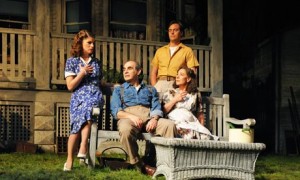
Main cast members of Arthur Miller’s Play
In All My Sons I was blown away by the two main actors’ performances. David Suchet’s reenactment of Joe and Zoë Wanamaker’s interpretation of Kate were absolutely extraordinary. For one, Suchet portrayed Joe’s sudden emotional changes flawlessly and with ease. One moment he could be furious, the mood convincingly illustrated in every corporeal and facial expression, and suddenly he would become vulnerable and distraught with tears streaming down his face. To me, the only negative aspects of the show were: the supporting cast’s American accents slipping at times (something I actually found amusing) and the set’s peculiar depiction of the Ohio countryside as looking more like the Louisiana bayou.
In the end though, All My Sons far exceeded the other theatre productions I’ve seen in London. Shakespeare’s Merry Wives of Windsor is still a favourite, especially since it was my first experience in the Globe Theatre. Bedlam, also in the Globe, was enjoyable only because of the jokes I shared with fellow classmates afterwards. I did love Les Misérables with its brilliant lighting, impressive set design, and Éponine’s angelic voice, but I wasn’t blown away by the performance (it did not help that my seat was in the uppermost balcony). 39 Steps was innovative and entertaining, but I found the slapstick humour dull after a while. The Habit of Art forced me to consider deeper, more intellectual ideas but was not the most well written play, I think. All in all, I have thoroughly enjoyed my theatre experience in London—although I would love to see some dance while I’m still here in England—and have appreciated every play and musical I have seen thus far.
If you haven’t see All My Sons yet, please do, and share your thoughts!
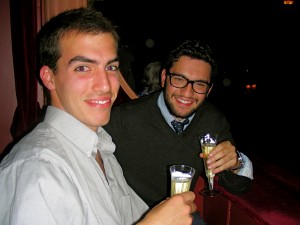
Patrick and Matt at the play All My Sons (personal photo)
Tags: 2010 Mary · Theatre















 [Elizabeth I coronation portrait- http://www.npg.org.uk/collections/search/portrait/mw02070/Queen-Elizabeth-I?sText=queen+elizabeth&submitSearchTerm_x=0&submitSearchTerm_y=0&search=ss&OConly=true&firstRun=true&LinkID=mp01452&role=sit&rNo=2)
[Elizabeth I coronation portrait- http://www.npg.org.uk/collections/search/portrait/mw02070/Queen-Elizabeth-I?sText=queen+elizabeth&submitSearchTerm_x=0&submitSearchTerm_y=0&search=ss&OConly=true&firstRun=true&LinkID=mp01452&role=sit&rNo=2)




 :
: Victoria and Albert, by Winterhalter.
Victoria and Albert, by Winterhalter.

